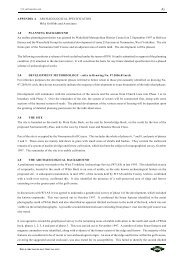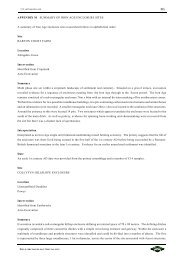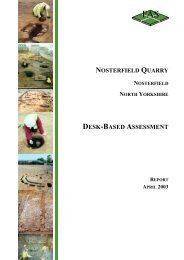ARCHAEOLOGICAL EVALUATION - Mike Griffiths and Associates
ARCHAEOLOGICAL EVALUATION - Mike Griffiths and Associates
ARCHAEOLOGICAL EVALUATION - Mike Griffiths and Associates
You also want an ePaper? Increase the reach of your titles
YUMPU automatically turns print PDFs into web optimized ePapers that Google loves.
FAS_lbf01.wpd 20<br />
ploughsoil in advance of disturbance, <strong>and</strong> also to provide a guide during machine excavation of the evaluation<br />
trenches. The machine excavated evaluation trenches represent a 2% sample of the application area. While the<br />
position of the trenches was determined partly by areas of higher potential identified during the earlier stages<br />
of the evaluation, a balance was struck whereby the trenching regime also provided a reasonable coverage of<br />
the site. Elongated rectangular trenches were employed to improve the probability of identifying boundary<br />
features <strong>and</strong> defining geological variation.<br />
3.1 ZONATION<br />
Due to the size of the site <strong>and</strong> the variation in l<strong>and</strong> use, the area of investigation was divided into six zones for<br />
the purposes of project management <strong>and</strong> recording (Figure 7, Table 1). This approach provided a means of<br />
assessing the likely variation in archaeological visibility, as well as predicting the relative success of individual<br />
investigative techniques.<br />
Table 1<br />
Zones of investigation<br />
Zone L<strong>and</strong> use<br />
A Arable, cereal crop in 2004<br />
B Arable, with access track to the north, cereal crop in 2004<br />
C Arable, cereal crop in 2004<br />
D Arable, beet crop in 2004<br />
E<br />
Pasture<br />
F<br />
Pasture with small pond to the south<br />
3.2 INTERVENTIONS<br />
In order to create a structured <strong>and</strong> consistent project archive from data-sets derived from the application of<br />
different techniques of investigation, each separate operation was assigned an intervention number (Table 2).<br />
An intervention was defined either by an area examined or by the application of a technique.<br />
Table 2<br />
Archaeological interventions<br />
Intervention Zone Activity Date<br />
1 A, B, C, D Fieldwalking Oct 2003, May 2004<br />
2 A, B, E, F Auger survey Oct 2003, Jan 2004<br />
3 F, E Topgraphic survey Oct 2003, Jan 2004<br />
4 A, B, C, E Magnetometer survey Nov-Dec 2003<br />
5 A, B, D Soil resistance survey Jan-Feb 2004<br />
6 A, B, C, D, E Test pits (x112 1m x 1m) March 2004, Aug-Oct 2004<br />
7 D Evaluation trench (100m x 4m) March 2004<br />
8 D Evaluation trench (50m x 4m) March 2004<br />
9 D Evaluation trench (100m x 4m) March 2004<br />
FIELD ARCHAEOLOGY SPECIALISTS







